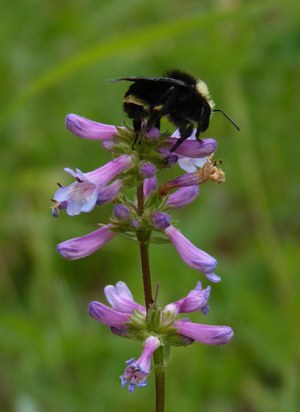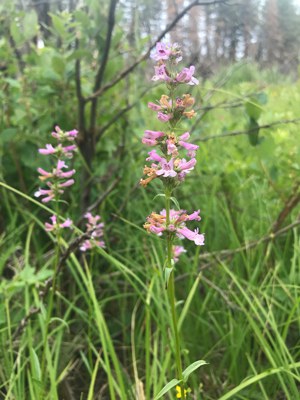Sometimes it’s easy to understand why a species is rare. Maybe a bird is found in only one specific habitat and that habitat is changed or destroyed. Sometimes a species is hunted or a plant is gathered towards extinction. But sometimes it’s a real mystery why a plant would be found on only 485 square miles of the planet.
We are lucky because over the years many scientists have been fascinated and studied this rare wildflower. There are robust and detailed field studies, genetic analyses, seed trials, and many other monitoring experiments summarized in the Forest Service Species Conservation Strategy which I had the honor of updating in my work as District Ecologist at the Sisters Ranger District.
Peck's penstemon is no fragile flower, it thrives and needs the disturbances common to its favorite habitats in our ponderosa pine forests, meadows, and intermittent steam channels. Flooding and fire create the wet conditions and bare mineral soil it needs to thrive. The seeds need to be wet for a while to germinate. But too much disturbance (think bulldozers) can eradicate the plants.
It’s hypothesized that it is a pretty new species in the game, evolving during or soon after the glaciations of the Pleistocene. This is indicated from its double set of chromosomes, an evolutionary consequence of hybridization. It was born in a landscape of volcanoes and glaciers and water flowing across the land. A couple of penstemon species cross pollinated and created a new species which preferred the odd combination of wet places in dry forests.
Dr Elizabeth King who completed a detailed genetic analysis in 1993, hypothesized that the newly formed hybrid grew in the large alluvial deposits left behind by the retreating glaciers that once occupied the Metolius River Basin. As the glaciers melted, the plant evolved a seed dispersal mechanism that helped it thrive in that wet climate, spreading its small seeds by water flows. But as the climate changed and dried, the seed dispersal mechanism and the seeds' special requirements for germination no longer allowed the species to expand its range beyond the outwash plains which wrap around Black Butte and head east towards Whychus Creek. 
This plant is well adapted to fire. I had the privilege of studying Peck's penstemon for more than 25 years and watching populations burn in a series of large wildfires on the Sisters Ranger District. The trees died but the wildflowers loved it. The densest populations I ever saw, stunning fields of Peck’s penstemon that made my heart race, were found in meadows surrounded by dead trees in the B&B Fire of 2003.
It was very strange that we rarely found seedlings. Maybe twice. The plant produces hundreds of seeds but they never seemed to sprout. Most plants spread vegetatively by rhizomes. We wanted to understand why and if this was a key to its small range. In 1992, Forest Botanist Cindi O’Neil proposed the hypothesis that Peck’s penstemon small seeds might decompose and lose viability quickly in the soil and this might be a key to explaining the plant’s rarity. She devised a seed survivorship study with Dr. Ed Guerrant at the Berry Botanic Garden.
We collected more than 62,000 seeds from 11 different populations across the known range of the plant. We then buried mixed seed lots in small cloth bags protected by a wire mesh cage, in the soil within the range of the plant, so that seeds would be subject to normal cycles of moisture and temperature. Forty pouches were buried in each of 3 locations. At specified intervals we dug up some packets and sent them off for analysis.
But over the first 15 years, the number of seeds that were potentially viable remained remarkably constant, with over 50% of the seeds remaining whole. After 15 years in the soil 29% of the seeds still germinated. After I retired, Beth Johnson, the new district ecologist, worked with me to once again relocate the long-buried seed lots and send off another batch of packets.
We were amazed to learn that even after 25 years about 26% of seeds still germinated. And very strangely, Dr Guerrant discovered that if seeds did not germinate, he could dry them and then wet them and retest and more seeds would germinate, even through three cycles of wetting and drying! It was clear that Peck’s penstemon can produce a soil seed bank that persists at least 25 years, and perhaps much longer. Just hanging out waiting for the perfect combination of conditions to wake up and grow.
So despite the fact that we know so many details about this beautiful wildflower, we still don’t know why it only grows here and nowhere else in the world. It’s a wildflower mystery.
Maret Pajutee is a retired Forest Service ecologist. She worked for more than 25 years protecting the natural resources of the Sisters Ranger District. She is an expert on the rare Peck’s penstemon, a wildflower found only in Sisters and nowhere else in the world.
Learn more:
- About the Peck's penstemon Forest Service Species Conservation Strategy
- About the Trout Creek Conservation Area
- About wildflowers of Central Oregon


